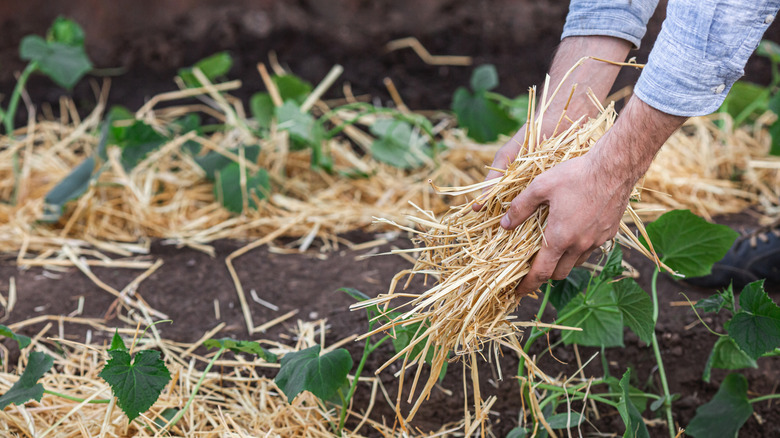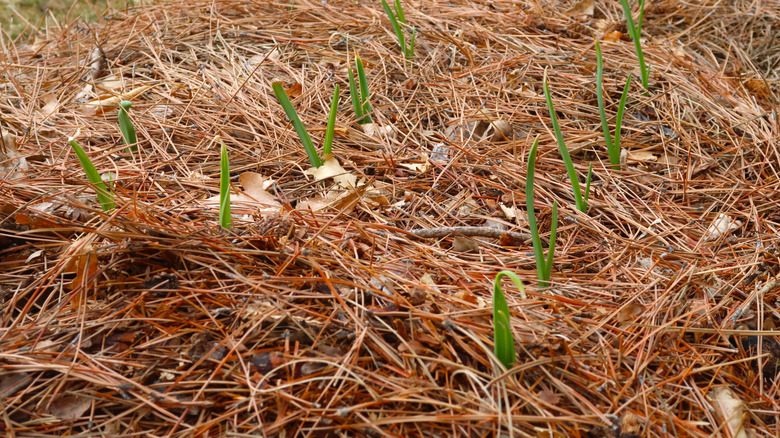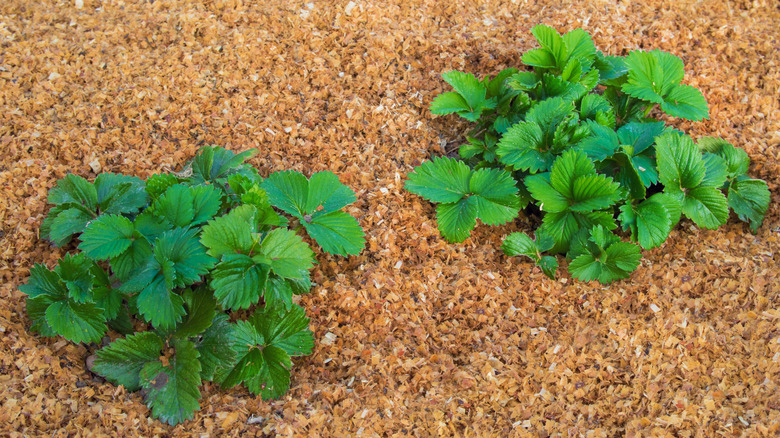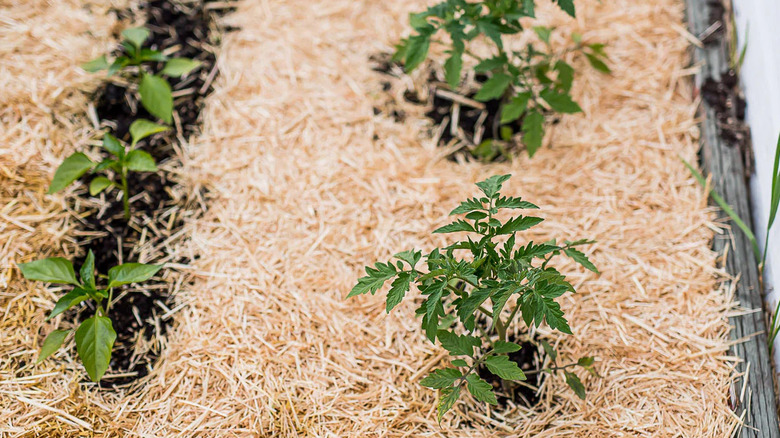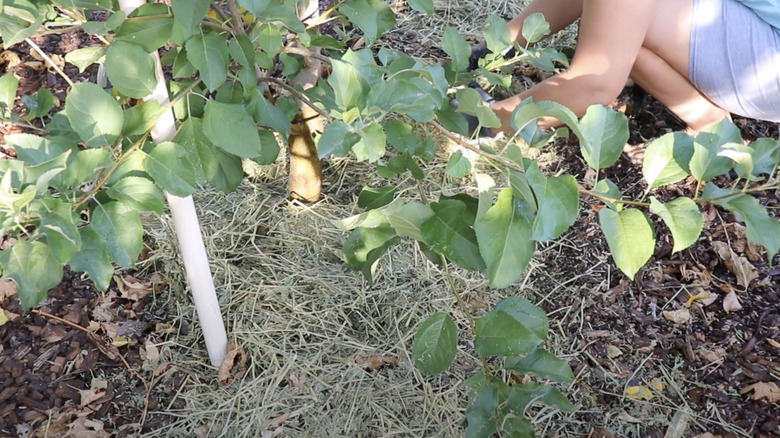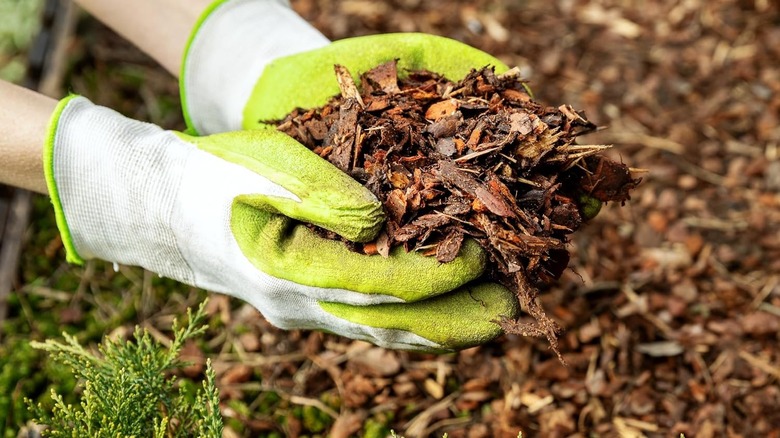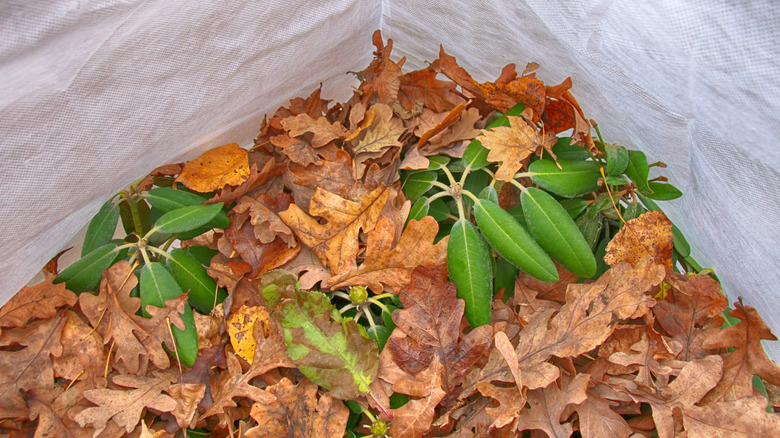Best Ingredients To Use In Your DIY Mulch
We may receive a commission on purchases made from links.
Want to suppress weeds, conserve moisture, and enrich your soil over time? The first step is choosing the best type of mulch for your garden. Although purchasing a specific mulch type is always an option, there are many perks to DIYing your own mulch at home. Mixing homemade ingredients improves a person's gardening knowledge, forcing one to learn what nutrients and benefits each ingredient has and how it impacts the soil. This approach also has the potential to save money and reduce landscaping waste, making it a worthy undertaking from multiple angles.
Below are seven ingredients to consider adding to your mulch blend. These materials are organic or inorganic and have different factors better suited for certain garden types. They each have their pros and cons, and some of them should be used in specific climates and times in the United States. Read on to learn about these mulch types, how to use them, where to find them, and, most importantly, what they do for your plants.
Pine needles create a permeable, airy mat that decomposes slowly and makes for great long-term mulch
Pine needles, known as pine straw mulch, make a wonderfully insulating cover around trees, shrubs, and perennial flowers. They work as multi-purpose mulch by providing temperature control, suppressing weed growth, retaining soil moisture, and improving water penetration. This yard waste absorbs moisture and helps to prevent the soil from drying out, its structure also allows water to filter through to the ground below. This is a valuable trait, as one issue with some mulches is that they can create a thick carpet that reduces the amount of water that flows down and reaches the soil. The shape of pine needles also creates a natural netting that helps them stay in place during rain, reducing erosion on hilly properties. Another benefit is that pine needles are waxy and resinous, which causes them to decompose slowly, making them a long-term mulching solution.
There was once a misconception that pine needles increased acidity in the soil. However, this has been debunked — the acid content reduces as pine needles decompose and doesn't significantly affect soil pH. In fact, it appears that they are not more acidifying than most other types of mulch. One note however: If you live in an area that's prone to wildfires, you should think twice before using pine needles as mulch, as it can be highly combustible.
If you reside in an area with copious pine trees, you may be able to gather enough free pine needles from your yard to spread around garden plants. Another option is to purchase Lowe's Long Leaf Pine Needles for approximately $115 per 240 square feet of yard space. Lay these or the naturally gathered pine needles about three to four inches thick. Don't worry about the material compacting from settling and moisture over time, as they naturally lay in a way that allows water and air to pass through. The only thing to be wary of is potential nitrogen loss. Raking in a layer of aged manure, compost, or applying nitrogen-rich fertilizer are some ways you can add nitrogen to your garden soil to help offset any loss that could come from mulching with organic matter like pine needles.
Aged sawdust is high in carbon and guaranteed weed-free
Composted or aged sawdust makes a great protective covering for trees, shrubs, perennial flowers, and vegetable gardens. It has a high carbon content that may remove nitrogen at first, but adds nutrients and biomass to the soil over time. The fine texture creates an impenetrable barrier that repels rain and irrigation water, which can be helpful when growing arid plants in wetter climates. The compact nature is excellent for repressing weed growth, too, though this compaction also comes with some caveats.
The cheapest way to acquire non-treated sawdust for mulch is to seek out local woodworkers and hobbyists in your area, as they might be looking to offload wood dust for free. You could also consider ordering something like Sunbelt's 15 oz Bag of Pine Sawdust, although be warned it costs more than a dollar per ounce. Specially making your own sawdust might not feel like the most efficient use of time, but with a handheld electrical planer you could probably fill a large bag in under an hour.
You should lay aged or composted sawdust about two to three inches thick, and it should only be an inch deep if it's freshly ground sawdust. Due to the characteristics that block water, provide insulation, and initially reduce nutrients, it is best used during the fall and winter to protect plants from frost. In either case, make sure this sawdust wasn't gathered from treated lumber to avoid getting chemicals like arsenic in the soil. Lay it alongside a root system, careful not to pile it close to the above-ground stem. Some gardeners remove sawdust mulch (or thin the layer) in the spring to avoid the risk of compaction during growing seasons. It can then be reapplied in the fall. Alternatively, to offset its predilection for compaction, you can also make a DIY mulch mix by combining sawdust with other, coarser materials like leaf mold and straw or even add aged manure to it. Finally, to offset any nitrogen loss in the soil from using pure sawdust, you can also mix it with a high-nitrogen fertilizer, such as the CZ Garden Urea Fertilizer.
Wheat and oat straw are natural byproducts of grains and augment soil health
If you're looking for a cheaper alternative to store-bought pine needles, surround trees, shrubs, and flower beds with oat or wheat straw to enrich soil and suppress weeds. These grain byproducts augment soil structure and improve soil fertility. The carbon-rich stalks contain cellulose, hemicellulose, and lignin which breaks down over time and help bind soil particles together. Mulching with straw can help prevent erosion and even improves trace metal absorption, while adding nutrition to the soil. Oat and wheat straw also block the top layer of soil from sunlight, which prevents weeds from growing and competing with intentional plants for nutrients.
Many gardeners use straw as an undercoat for other mulch ingredients. It's relatively cheap compared to other types of mulch and attracts earthworms, making it especially beneficial to plant health. The most economical place to get hold of straw is probably at your local farmer's co-op, where you'll be able to buy it by the bale for between $10 and $65. You can also pick up bales of straw at places like Lowe's and The Home Depot. Ideally, try to find bales that are marked as weed-free.
Before laying straw mulch, ensure the garden is fully fertilized with compost or aged manure. Lay oat and wheat straw at any time of the year, beginning by fluffing the straw to create a light and airy layer. Spread the straw about three to four inches deep around seeding beds and plants without covering stems and leaves. In most cases, you can leave the straw alone to decompose. Only remove it if visible mold starts to form. If it's thinned out, you can simply apply a new layer of straw.
Alfalfa hay has higher concentrations of essential plant nutrients than other mulches
Alfalfa hay makes a great mulch, whether you purchase it to feed farm animals or are solely considering it as an ingredient in your garden. It has the usual benefits associated with most organic mulches, including suppressing weeds and moderating soil moisture and temperatures. Alfalfa hay also releases high concentrations of nitrogen, phosphorus, and potassium into the soil. It's much longer-lasting than straw, and using spoiled bales reduces waste from excess animal feed. There's also a growth-stimulating hormone in Alfalfa hay, triacontanol, which, when released into the soil has the potential to accelerate plant growth.
Lay alfalfa in the same manner that pine needles, oat straw, and wheat straw are applied. Fluff the hay before piling it a few inches deep around the stems of plants, giving enough space for airflow and ventilation. Because alfalfa hay is used as a feed for livestock and horses, it's available in bales, and animal feed stores typically offer better pricing. Rural King and Tractor Supply carry a 50-pound Standlee Premium Alfalfa Grab & Go Compressed Bale for $24.99 and $25.99, respectively, which is almost half the price of other retailers. Besides mulching with alfalfa hay, you can also mix alfalfa pellets with a bucket of water to create an organic liquid fertilizer that'll do wonders for your garden soil. Or you can even opt for something like the Alfagrow 10 Pounds Alfalfa Pellet Fertilizer.
Cedar or cypress bark mulch comes in all sizes for aesthetic and functional purposes
Cedar and cypress bark mulch are ingredients that excel as mulching materials for trees, shrubs, and perennial flowers. These organic materials come in different particle sizes. They are often colored or dyed to befit certain aesthetics and landscape designs. They decompose slowly and are guaranteed weed seed-free, giving them multiple pros over other mulch types. Cedar retains water, prevents weeds, insulates soil, and has an attractive color, even in its natural form. It also has a reputation for being the best type of mulch to keep bugs away.
Although dyed mulch makes a landscape more exciting and colorful, it has downsides. Some dyed bark mulch contains contaminants. Contrary to popular assumption, it's not the dyes that are toxic. Dyed mulch is often manufactured from recycled wood which may contain chromated copper arsenate. If you are wondering is colored mulch safe to use in my garden, the answer is that it can be, provided you source non-recycled wood chips from a trusted supplier.
Fortunately, you also don't have to worry about any of this if you DIY your mulch blend. If you happen to have some cedar trees on your property that you want to fell, you can either ask the arborist to chip the wood for you, or, if you're dropping the trees yourself, rent a chipper from an outlet like The Home Depot. Another option is to order pre-cut lumber chips through ChipDrop. ChipDrop connects arborists needing to get rid of wood chips with gardeners looking for free mulch. Just make sure you ask for hardwood chips and not those from invasive trees. The wood from an invasive species isn't necessarily bad, but there is the risk of seeds in the wood chips spreading into your yard and the surrounding ecosystem. Once the mulch is acquired, pile it two to three inches deep. Depending on how wet your climate is and how fast the wood chips deteriorate from outdoor exposure, you may have to replace them once a year or every few years.
Oak leaf mulch releases nitrogen, phosphorus, and sulfur into the soil and can be mixed lightly with grass clippings
Oak leaf mulch is a food source for both plants and other living organisms in the soil. Oak leaves release nitrogen, phosphorus, and sulfur, which feeds good bacteria, fungi, insects, and worms. This creates a healthy environment for them to flourish and benefit nearby plant life. When used as mulch, oak leaves prevent weed growth, retain water, and provide sustenance. Like pine needles, oak leaves were once surrounded by the misconception that they are only good for plants that prefer acidic soil. However, published research conducted at the Hancock Turfgrass Research Center revealed that this isn't the case. Even after mulching with oak leaves for six consecutive seasons, soil pH did not change. So, feel free to mulch numerous plant species with oak leaves, not just azaleas.
Oak leaves are easy to acquire throughout most of the United States since they're one of the most popular tree species. Fallen oak leaves are free if you have fully grown oaks in your landscape or neighbors willing to give you their yard waste. Shred the leaves to make them break down faster and lay them about two to three inches deep and one to two inches away from trees and ornamental plants. You can also give your oak leaf-based mulch a nitrogen boost by mixing in some grass clippings. Grass clippings are a fantastic source of nitrogen and a handy complement to oak leaves, which have a very high carbon content (the exact ratio of carbon to nitrogen in oak leaves is 60:1). Adding in a source of nitrogen can help speed up their decomposition and the rate at which they'll feed your soil. Grass clippings on their own aren't the greatest mulching material, as they tend to compact down, creating an impermeable mat that doesn't let water through. Mixing them with oak leaves helps to keep the mulch layer light and airy, while adding in that all-important source of nitrogen.
Tumbled glass mulch is inorganic, DIYable, and doesn't affect the nutrition of finicky plants
With all the ways you can use mulch in your yard and garden, most of the best choices are organic materials. However, an inorganic option like glass can also be beneficial for landscapes. Recycled glass mulch, also known as "cullet", is sustainable and creates use of something that would otherwise go to landfills. It's good for drainage, especially for arid landscapes filled with succulents and other drought-tolerant plant species. Inorganic mulches like glass also moderate soil temperature, don't get compacted, and won't impact soil fertility or cause any nutritional changes.
In addition to its functional benefits, tumbled glass comes in various colors to befit any landscape or home exterior. Because it's tumbled, glass mulch isn't sharp or dangerous, and there's no risk of being cut. It doesn't release hazardous toxins into the earth and is inert.
YouTuber NelsonStudios recommends contacting a glass replacement company and asking if they have any glass they're disposing of. They may charge you for it, or give it to you for free. Mix the glass with rock grit in a concrete mixer — you can find rock grit at a hobby store or purchase the KomeStone Rock Tumbler Grit and Polish Refill Kit from Amazon. The concrete mixer will be expensive and loud, and your best bet is to warn your neighbors beforehand and rent an electric concrete mixer from Home Depot for a day. It'll take eight to ten hours to mix, and NelsonStudios also recommends wrapping the mixer in a blanket to reduce the noise slightly. Once the homemade mulch is tumbled, you're all set to apply it about two to three inches deep.
